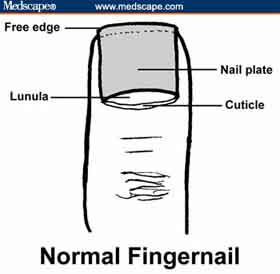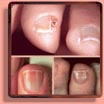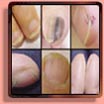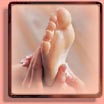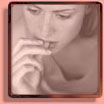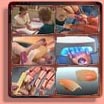|
|
Elderly people carry the last 6 months of their medical record on the approximately 10 square centimeters of keratin comprising the fingernails. Examining the fingernails can help the clinician detect a number of general and specific factors, including the following:
Overall vitality;
Inner emotional state;
Cerebral dominance;
Occupations and hobbies;
Medical history;
Nutritional status;
Cardiovascular function;
Rheumatic conditions; and
Dermatologic problems.
|
The patient's manicure can reveal state of health, nutritional status, past events, personality, occupation, and one's inner state. Systemic illness should show the nail changes in each of the nails on one hand. The thumb may reveal more extensive changes given its increased size.
It is useful to follow the following sequence when examining the nails:
Check the nail shape;
Examine the nail color;
Survey processes around the nails;
Compare hands; and
Note skin conditions.
It is critical to examine the nails in adequate light. Gently rotate the nail in the light so that the reflection highlights all aspects of the nail. Notice the lunula, the pale crescent moonlike coloration at the base of the nail. Leukonychia striata and a pointed tent-like lunula suggest an excessive manicure and pushing on the cuticle. Paronychias suggest stress and poor attention to hand hygiene. This can reflect depression, dementia, or psychiatric illness.
Nail Growth:
Nail growth is continuous. It takes about 6 months for a fingernail in an elderly person to completely grow out. Cold temperature can slow growth rates but not to any clinically significant degree (pun intended). The middle finger nail grows the fastest, followed by the forefinger and ring finger. Aging slows the growth rate from approximately 3 months in childhood to 6 months in 70-year-olds. Nails in elderly people are also thicker than in younger people. Thin nails in a postmenopausal woman raise the possibility of metabolic bone disease. The nails of the dominant hand grow slightly more quickly than the nondominant nails, probably because minor trauma accelerates nail growth. Conversely, immobility slows the growth rate of fingernails. Understanding the growth rate is important because the time interval from a critical event can be estimated from the location of a nail lesion. For example, a white line appearing transversely halfway up the nail suggests an acute illness 3 months earlier. Regular observation will demonstrate its progression to the end of the nail edge.
Nail Polish:
Distance from base and line of polish gives approximate date of application (nails grow 0.1 mm/day). Picking at polish reflects nervousness and agitation. Toenail polish suggests unusual flexibility or a friendly helper.
|
CONTINUE THIS ARTICLE:
Page 1 of 5 - Next Page
TIP!!! - The hands of children: fingernail disorders in childhood
MORE NAIL RESOURCES:
HAND READING NEWS
|
